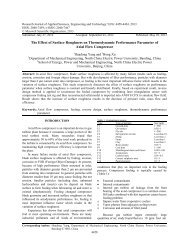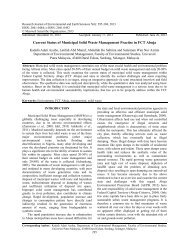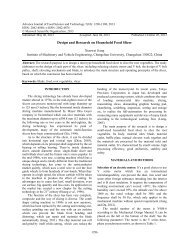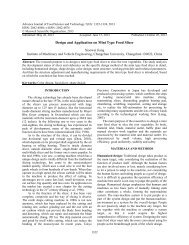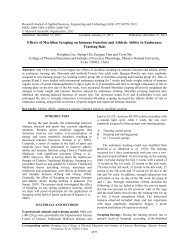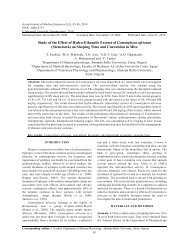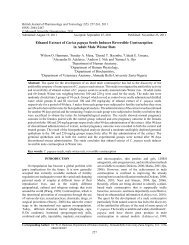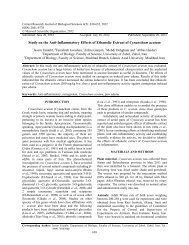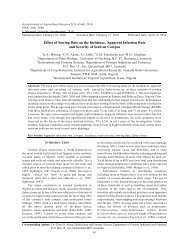Antibacterial Activity of Nigella sativa L. Seed ... - Maxwell Science
Antibacterial Activity of Nigella sativa L. Seed ... - Maxwell Science
Antibacterial Activity of Nigella sativa L. Seed ... - Maxwell Science
You also want an ePaper? Increase the reach of your titles
YUMPU automatically turns print PDFs into web optimized ePapers that Google loves.
British Journal <strong>of</strong> Pharmacology and Toxicology 1(2): 96-100, 2010<br />
ISSN: 2044-2467<br />
© <strong>Maxwell</strong> Scientific Organization, 2010<br />
Submitted date: August 30, 2010 Accepted date: September 24, 2010 Published date: November 15, 2010<br />
<strong>Antibacterial</strong> <strong>Activity</strong> <strong>of</strong> <strong>Nigella</strong> <strong>sativa</strong> L. <strong>Seed</strong> Extracts<br />
1 T.V. Suresh Kumar, 2 P.S. Negi and 1 K. Udaya Sankar<br />
1 Food Engineering Department,<br />
2 Human Resource Development Department, Central Food Technological Research Institute,<br />
(Council <strong>of</strong> Scientific and Industrial Research), Mysore-570 020, Karnataka, India<br />
Abstract: Most <strong>of</strong> the bacterial pathogens are resistant to existing synthetic antibacterial agents demanding an<br />
increasing effort to seek effective phytochemicals as antibacterial agents against such pathogens. <strong>Nigella</strong> <strong>sativa</strong><br />
L. (black cumin) seeds play an important role in folk medicine and some <strong>of</strong> its major constituents are reported<br />
to be pharmacologically active. In this present work, black cumin seed extracts were obtained using<br />
supercritical carbon dioxide (SCCO 2) and conventional soxtec extraction using various organic solvents. The<br />
antibacterial activities <strong>of</strong> the extracts were investigated by the agar dilution method against Gram-positive<br />
bacteria (Bacillus cereus F 4810 and Staphylococcus aureus FRI 722) and Gram-negative bacteria (Escherichia<br />
coli MTCC 108 and Yersinia enterocolitica MTCC 859). SCCO 2-1 (120 bar/40ºC) extract showed effective<br />
growth inhibition than conventional solvent extracts against all the tested bacteria. Further the antibacterial<br />
principle present in the extract was isolated and characterized found to be thymoquinone.<br />
Key words: Agar dilution method, black cumin, 1 H and 13 C NMR, supercritical CO 2 extraction, thymoquinone<br />
INTRODUCTION<br />
The problem <strong>of</strong> microbial resistance and degenerative<br />
diseases are growing and the outlook for the use <strong>of</strong><br />
synthetic drugs without adverse effects in the future is still<br />
uncertain. Synthetic drugs also block receptor sites and<br />
hence attempts are being made to control the use <strong>of</strong><br />
synthetic drugs and develop new drugs from natural<br />
resources like medicinal plants. Medicinal plants are<br />
important therapeutic aids for various ailments and the<br />
use <strong>of</strong> those that are native to India in various traditional<br />
system <strong>of</strong> medicine are awe inspiring.<br />
Pharmacologically active seeds <strong>of</strong> <strong>Nigella</strong> <strong>sativa</strong> L.<br />
(Ranunculaceae family), is found in southern Europe,<br />
northern Africa and Asia Minor. The seeds are small,<br />
black and possess aromatic odor and taste. The seeds<br />
commonly known as black seed or black cumin or kalunji<br />
have been extensively investigated in recent years and<br />
used in folk medicine as a natural remedy for a number <strong>of</strong><br />
diseases such as asthma, hypertension, diabetes,<br />
inflammation, cough, eczema, fever and gastrointestinal<br />
disturbances. <strong>Seed</strong> oil also has antipyretic, analgesic and<br />
antineoplastic activity (Ali and Blunden, 2003).<br />
Thymoquinone, an active constituent <strong>of</strong> <strong>Nigella</strong> <strong>sativa</strong><br />
seeds, is a pharmacologically active quinone, which<br />
possesses several pharmacological properties including<br />
analgesic and anti-inflammatory actions (Abdel-<br />
Fattah et al., 2000; Randhawa and Al-Ghamdi, 2002).<br />
Selection <strong>of</strong> extraction technique is important to<br />
extract substances or group <strong>of</strong> constituents <strong>of</strong> interest.<br />
Many <strong>of</strong> these bioactive constituents possess high<br />
volatility, thermo sensitivity and photo reactivity. Hence,<br />
the evaluation <strong>of</strong> the extraction process related to its<br />
efficiency to reach target constituents from a solid matrix<br />
is <strong>of</strong> considerable relevance. The development <strong>of</strong> new<br />
extraction technique has gained increasing importance in<br />
the pharmaceutical and food industries in recent years.<br />
Supercritical Fluid Extraction (SFE) <strong>of</strong> bioactive<br />
constituents from plant material is a promising field for<br />
the industrial application (Reverchon, 1997), since it has<br />
certain advantages over steam-distillation and solvent<br />
extraction. Steam-distillation can lead to thermal<br />
degradation and partial hydrolysis <strong>of</strong> some essential oil<br />
compounds, while SFE can be performed at lower<br />
temperatures, thereby preserving the original extract<br />
composition and properties. Carbon dioxide is the most<br />
used supercritical solvent in extractions <strong>of</strong> active<br />
constituents, especially for application in pharmaceutical,<br />
cosmetic and food industries. Carbon dioxide is non toxic<br />
and allows SFE at temperatures near room temperature<br />
and relatively low pressures (8-10 MPa). To suppress coextraction<br />
<strong>of</strong> higher molecular weight constituents, Udaya<br />
Sankar (1989) and Reverchon (1997) suggested<br />
performing SFE <strong>of</strong> essential oil at temperatures <strong>of</strong> 40-<br />
50ºC and pressures below 10 MPa.<br />
The objective <strong>of</strong> this study is to investigate the<br />
antibacterial activity <strong>of</strong> <strong>Nigella</strong> <strong>sativa</strong> seed various<br />
extracts obtained by SCCO 2 and conventional solvent<br />
extraction against different bacterial pathogens and to<br />
characterize the antibacterial principle: thymoquinone.<br />
Corresponding Author: K. Udaya Sankar, Food Engineering Department, Central Food Technological Research Institute,<br />
(Council <strong>of</strong> Scientific and Industrial Research), Mysore-570 020, Karnataka, India.<br />
Tel: +91 821 2514874; Fax: +91 821 2517233<br />
96
MATERIALS AND METHODS<br />
This study was conducted during the period <strong>of</strong> April<br />
2009 to June 2010 in our laboratories at Food<br />
Engineering Department and Human Resource<br />
Development Department <strong>of</strong> Central Food Technological<br />
Research Institute, (Council <strong>of</strong> Scientific and Industrial<br />
Research), Mysore.<br />
<strong>Nigella</strong> <strong>sativa</strong> seeds: The seeds were obtained from<br />
Supreem Pharmaceuticals Mysore Pvt. Ltd., India.<br />
Cleaned seeds were pulverized into a fine powder by an<br />
IKA-10 laboratory mill.<br />
SCCO 2 extraction: SCCO 2 extraction was carried out in<br />
Nova Swiss high pressure extractor as described earlier<br />
(Udaya Sankar, 1989). Extractions were carried out on<br />
1 kg <strong>of</strong> the pulverized black cumin seeds at 40 and 50ºC<br />
at 120 and 280 bar pressures. CO 2 flow rate was 1.2 to 2.9<br />
Kg/hr to obtain SCCO 2-1 (120 bar/40ºC) and SCCO 2-2<br />
(280 bar/50ºC) extracts. Yield <strong>of</strong> extracts were monitored<br />
by weight <strong>of</strong> extract recovered and then stored at 4ºC in<br />
dark until analysis.<br />
Soxtec extraction: 5 g <strong>of</strong> powdered seed was used in a<br />
soxtec apparatus and boiled in respective solvents <strong>of</strong><br />
hexane, ethyl acetate, methanol, and methanol: Water<br />
(70:30 v/v) for 30 min and extracted for 3 h. After<br />
extraction, the solvents were removed by rotary vacuum<br />
evaporator (40ºC) and dried in a vacuum oven at 30ºC for<br />
2 h.<br />
Preparation <strong>of</strong> extracts: The known quantities <strong>of</strong> solvent<br />
free extracts and SCCO 2 extracts were dissolved in<br />
propylene glycol for evaluation <strong>of</strong> antibacterial activity.<br />
Test bacteria: The microorganisms used were as follows,<br />
Bacillus cereus F 4810 (Public Health Laboratory,<br />
London, UK), Staphylococcus aureus FRI 722 (Public<br />
Health Laboratory, The Netherlands), Escherichia coli<br />
MTCC 108 and Yersinia enterocolitica MTCC 859<br />
(Microbial Type Culture Collection, Institute <strong>of</strong> Microbial<br />
Technology, Chandigarh, India).<br />
Culture medium: Nutrient agar and brain heart infusion<br />
agar media and respective broths were used in the present<br />
studies.<br />
<strong>Antibacterial</strong> activity: The antibacterial activity was<br />
determined by agar dilution method (Negi et al., 1999)<br />
against the test bacteria. Yersinia enterocolitica was<br />
grown in brain heart infusion agar and the remaining test<br />
bacteria were grown in nutrient agar at 37ºC. Each<br />
bacterial strain was transferred from stored slants at 4-5ºC<br />
to 10 mL <strong>of</strong> broth and incubated overnight at 37ºC. A<br />
Br. J. Pharm. Toxicol., 1(2): 96-100, 2010<br />
97<br />
preculture was prepared by transferring 1 mL <strong>of</strong> culture to<br />
9 mL <strong>of</strong> broth and was cultivated for 48 h. The cells were<br />
harvested by centrifugation (1200 g, 5 min), washed and<br />
suspended in sterile saline under aseptic conditions.<br />
To flasks containing 20 mL <strong>of</strong> melted cool agar,<br />
different concentrations <strong>of</strong> extracts in propylene glycol<br />
were added. An equivalent amount <strong>of</strong> propylene glycol<br />
was used as controls. One hundred l (about 10 3 cfu/mL)<br />
<strong>of</strong> each bacterium to be tested were inoculated into the<br />
flasks under aseptic conditions. The media were then<br />
poured into sterile petri dishes, in triplicate, and incubated<br />
at 37ºC for 20-24 h. After the incubation period, the<br />
colonies were enumerated and were used to find out the<br />
growth inhibition by using the following formula:<br />
Inhibition (%) = (1 - T/C) × 100<br />
where, T is cfu/ml <strong>of</strong> extract and C is cfu/mL <strong>of</strong> control.<br />
The lowest concentrations <strong>of</strong> the extracts capable <strong>of</strong><br />
inhibiting the complete growth <strong>of</strong> the bacteria being tested<br />
were expressed as Minimum Inhibitory Concentration<br />
(MIC) values.<br />
Purification: 5 mL <strong>of</strong> SCCO 2-1 extract was subjected to<br />
purification in a glass column (40 × 450 mm) packed with<br />
activated silica gel (60-120 mesh) and eluted with hexane<br />
and ethyl acetate at 99:1 ratio. Fractions were collected<br />
and continuously monitored by Silica gel-G coated TLC<br />
plates with hexane: ethyl acetate (90:10 v/v) as<br />
developing solvent. The spots were located by exposing<br />
the plates to iodine vapors. Fractions having the similar<br />
pattern <strong>of</strong> the spots with similar Rf values were pooled<br />
and concentrated. It was used for spectral characterization<br />
studies.<br />
Characterization <strong>of</strong> thymoquinone:<br />
Spectral characterization: Isolated thymoquinone<br />
besides measuring melting point was characterized<br />
spectroscopically by UV, IR, Mass and Two-Dimensional<br />
Heteronuclear Single Quantum Coherence Transfer (2D<br />
HSQCT) NMR spectra. Mass spectra were obtained using<br />
a Q-TOF Waters Ultima mass spectrometer. 2D HSQCT<br />
were recorded along with 1 H and 13 C NMR spectra on a<br />
Bruker Avance AQS-500 MHz NMR spectrometer<br />
(500.13 MHz for 1 H and 125 MHz for 13 C) at 35ºC using<br />
5 mg <strong>of</strong> the isolated thymoquinone in DMSO-d6 solvent.<br />
In the NMR data, only resolvable signals are shown.<br />
Some <strong>of</strong> the assignments are interchangeable. Certain<br />
quaternary carbons and proton signals could not be<br />
detected.<br />
Thymoquinone: Solid, mp 45.5ºC; UV (alcohol, max):<br />
278 nm ( *, 278-2420 M 1 ); IR (KBr) (stretching
Br. J. Pharm. Toxicol., 1(2): 96-100, 2010<br />
Bacillus cereus Staphylococcus aureus<br />
Escherichia coli Yersinia enterocolitica<br />
Fig. 1: Inhibition <strong>of</strong> bacterial growth by black cumin seed extracts: 1. SCCO 2-1 (120 bar/40 C); 2. SCCO 2-2 (280 bar/50 C); 3. Ethyl<br />
acetate; 4. Methanol; 5. Hexane; 6. Methanol: Water (70:30 v/v) (SD values varied from 0-1.70% for Bacillus cereus, 0.39-<br />
2.03% for Staphylococcus aureus, 0-1.68% for Escherichia coli, and 0.10-1.42% for Yersinia enterocolitica)<br />
frequency): 2970 cm 1 (CH), 1690 cm 1 (C=O); MS<br />
(m/z) 164.12 [M] + ; 2D HSQCT (DMSO-d 6) 1 H NMR ppm<br />
(500.13): 6.59 (H-2), 6.72 (H-5), 2.12 (H-8, 5.3 Hz), 1.93<br />
(H-9, 5.3 Hz), 1.94 (H-10, 5.3 Hz); 13 C NMR ppm (125<br />
MHz): 145.1 (C1), 133.5 (C2), 188.3 (C3), 187.3 (C4),<br />
133.3 (C5), 156.4 (C6), 14.9 (C7), 31.0 (C8), 26.7 (C9),<br />
26.7 (C10).<br />
Quantification <strong>of</strong> thymoquinone: Quantification was<br />
carried out by HPLC on a C18 reversed-phase <br />
Bondapak analytical column (300 x 3.9 mm, 10 m<br />
particle size), using an isocratic mobile phase <strong>of</strong> water:<br />
methanol: 2-propanol (50:45:5% v/v) at a flow rate <strong>of</strong> 1<br />
ml/min. The elution was monitored by diode array<br />
detector at 254 nm.<br />
RESULTS AND DISCUSSION<br />
The present investigation reveals that the SCCO 2<br />
extracts showed an effective antibacterial activity against<br />
the tested bacteria than the conventional solvent extracts.<br />
The SCCO 2-1 (120 bar/40ºC) extract was more effective<br />
to inhibit the growth <strong>of</strong> tested bacteria which was<br />
98<br />
followed by SCCO 2-2 and then by ethyl acetate extracts<br />
(Fig. 1). Bacillus cereus, Staphylococcus aureus and<br />
Escherichia coli showed maximum inhibition to both<br />
SCCO 2 and solvent extracts except methanol: water<br />
(70:30 v/v) extract. These observations were reflected in<br />
the MIC values <strong>of</strong> these extracts for different bacteria.<br />
MIC value <strong>of</strong> the SCCO 2-1 extract for different bacteria<br />
was the lowest at 100-350 ppm followed by SCCO 2-2 and<br />
ethyl acetate extracts. Yersinia enterocolitica was the<br />
most resistant bacterium to all the tested extracts as<br />
inferred from higher MIC values observed for it (Table 1).<br />
All the evaluated extracts were found to be active<br />
against Gram-positive than Gram-negative bacteria. The<br />
higher resistance <strong>of</strong> Gram-negative bacteria to external<br />
agents has been earlier documented, and it is attributed to<br />
the presence <strong>of</strong> lipopolysaccharides in their outer<br />
membranes, which make them inherently resistant to<br />
antibiotics, detergents and hydrophilic dyes (Nikaido and<br />
Vaara, 1985). Results <strong>of</strong> the present study are consistent<br />
with the literature data reported by Agarwal et al. (1979)<br />
and Alhaj et al. (2008).<br />
Thymoquinone was characterized spectroscopically<br />
by UV, IR, Mass and 2D HSQCT NMR. 1 H and 13 C 2-D
Br. J. Pharm. Toxicol., 1(2): 96-100, 2010<br />
Table 1: M inimum inhibitory concentration (M IC) <strong>of</strong> black cumin seed extracts<br />
Extracts MIC a (ppm)<br />
-----------------------------------------------------------------------------------------------------------------------------------------------<br />
Bacillus cereus Staphylococcus aureus Escherichia coli Yersinia enterocolitica<br />
SCCO 2 -1 (120bar/40ºC) 100 175 300 350<br />
SCCO 2-2 (280 bar/50ºC) 150 175 300 450<br />
Ethyl acetate 150 200 300 500<br />
Methanol 150 200 300 500<br />
Hexane 150 225 300 550<br />
Methanol: water (70:30 v/v) 200 250 350 550<br />
a : MIC is defined as the lowest concentration <strong>of</strong> the extract capable <strong>of</strong> inhibiting the complete growth <strong>of</strong> the bacterium<br />
Fig. 2: ESI (-ve) MS finger print <strong>of</strong> purified SCCO 2-1 (120 bar/40ºC) extract <strong>of</strong> black cumin seeds<br />
Table 2: Thymoquinone content and extract yield for different extracts<br />
<strong>of</strong> black cumin seed<br />
Extracts Thymoquinone Extract yield a<br />
content (%) (%)<br />
SCCO2-1 (120bar/40ºC) 12.3±0.24 07.8±0.32<br />
SCCO2-2 (280 bar/50ºC) 07.1±0.32 26.0±1.21<br />
Ethyl acetate 03.2±0.05 42.7±1.21<br />
Methanol 02.7±0.16 37.3±1.30<br />
Hexane 01.2±0.11 32.0±1.01<br />
Methanol: water (70:30 v/v) 00.6±0.03 10.6±0.48<br />
a<br />
: Extracts yield were expressed as % on dry weight basis <strong>of</strong> seeds<br />
HSQCT spectra showed the presence <strong>of</strong> two carbonyl<br />
groups at 187.3 ppm and 188.3 ppm. Further, two<br />
aromatic protons were detected at 6.59 ppm and 6.72<br />
ppm. A CH 3 group attached to an aromatic ring was<br />
detected at 14.9 ppm in the carbon spectrum. The<br />
presence <strong>of</strong> isopropyl group was detected by observing<br />
signals at 1.93 ppm and 1.94 ppm (doublet) and 2.12 ppm,<br />
all with the coupling constant <strong>of</strong> 5.3 Hz. A typical ESI<br />
(- ve) MS finger print <strong>of</strong> purified SCCO 2-1 extract was<br />
depicted in Fig. 2 showed good correspondence for an m/z<br />
value <strong>of</strong> 164. All these confirmed that it could be the<br />
antibacterial principle: thymoquinone.<br />
Using the calibration curve, the quantification <strong>of</strong><br />
thymoquinone was achieved at 254 nm ranging from 0.6<br />
to 12.3% (Table 2). SCCO 2-1 extract had higher<br />
thymoquinone content <strong>of</strong> 12.3% which is in agreement<br />
with similar values reported by Erkan et al. (2008). The<br />
extracts yield was calculated based on dry weight <strong>of</strong> the<br />
seed material and it ranged from 7.8 to 42.7% dw<br />
(Table 2).<br />
99<br />
CONCLUSION<br />
The present study shows that supercritical CO 2<br />
extraction at 120 bar/40ºC is effective to obtain <strong>Nigella</strong><br />
<strong>sativa</strong> extracts with antibacterial activity and better<br />
recovery <strong>of</strong> thymoquinone. It was also found that, the<br />
maximum recovery <strong>of</strong> thymoquinone without degradation<br />
is possible only in SCCO 2 extraction, which was higher<br />
than to conventional solvent extracts besides exhibiting a<br />
direct correlation to antibacterial activity.<br />
ACKNOWLEDGMENT<br />
The first author acknowledges the management <strong>of</strong><br />
RVS College <strong>of</strong> Arts and <strong>Science</strong>, Coimbatore, Tamil<br />
Nadu, India for sponsoring as a Teacher Research Fellow<br />
at CFTRI, Mysore and also the Director <strong>of</strong> CFTRI,<br />
Mysore for providing the necessary facilities.<br />
REFERENCES<br />
Abdel-Fattah, A.F.M., K. Matsumoto and H. Watanabe,<br />
2000. Antinociceptive effects <strong>of</strong> <strong>Nigella</strong> <strong>sativa</strong> oil<br />
and its major component, thymoquinone, in mice.<br />
Eur. J. Pharmacol., 400: 89-97.<br />
Agarwal, R., M.D. Kharya and R. Shrivastava, 1979.<br />
Antimicrobial and anthelmintic activities <strong>of</strong> the<br />
essential oil <strong>of</strong> <strong>Nigella</strong> <strong>sativa</strong> Linn. Ind. J. Exp.<br />
Biol., 17: 1264-1265.
Alhaj, N.A., M.N. Shamsudin, H.F. Zamri and<br />
R. Abdullah, 2008. Extraction <strong>of</strong> essential oil from<br />
<strong>Nigella</strong> <strong>sativa</strong> using supercritical carbon dioxide:<br />
Study <strong>of</strong> antibacterial activity. Am. J. Pharmacol.<br />
Toxicol., 3: 225-228.<br />
Ali, B.H. and G. Blunden, 2003. Pharmacological and<br />
toxicological properties <strong>of</strong> <strong>Nigella</strong> <strong>sativa</strong>. Phytother.<br />
Res., 17: 299-305.<br />
Erkan, N., G. Ayranci and E. Ayranci, 2008. Antioxidant<br />
activities <strong>of</strong> rosemary (Rosmarinus <strong>of</strong>ficinalis L.)<br />
extract, black seed (<strong>Nigella</strong> <strong>sativa</strong> L.) essential oil,<br />
carnosic acid, rosmarinic acid and sesamol. Food<br />
Chem., 110: 76-82.<br />
Negi, P.S., G.K. Jayaprakasha, L.J.M. Rao and<br />
K.K. Sakariah, 1999. <strong>Antibacterial</strong> activity <strong>of</strong><br />
turmeric oil - A byproduct from curcumin<br />
manufacture. J. Agric. Food Chem., 47: 4297-4300.<br />
Br. J. Pharm. Toxicol., 1(2): 96-100, 2010<br />
100<br />
Nikaido, H. and M. Vaara, 1985. Molecular basis <strong>of</strong><br />
bacterial outer membrane permeability. Microbiol.<br />
Rev., 49: 1-32.<br />
Randhawa, M.A. and M.S. Al-Ghamdi, 2002. A review <strong>of</strong><br />
the pharmacotherapeutic effects <strong>of</strong> <strong>Nigella</strong> <strong>sativa</strong>.<br />
Pak. J. Med. Res., 41: 77-83.<br />
Reverchon, E., 1997. Supercritical fluid extraction and<br />
fractionation <strong>of</strong> essential oils and related products. J.<br />
Supercrit. Fluids., 10: 1-37.<br />
Udaya Sankar, K., 1989. Studies on physico-chemical<br />
characteristic <strong>of</strong> essential oil <strong>of</strong> pepper (Piper nigrum<br />
L.) obtained by supercritical carbon dioxide. J. Sci.<br />
Food. Agric., 48: 105-112.



